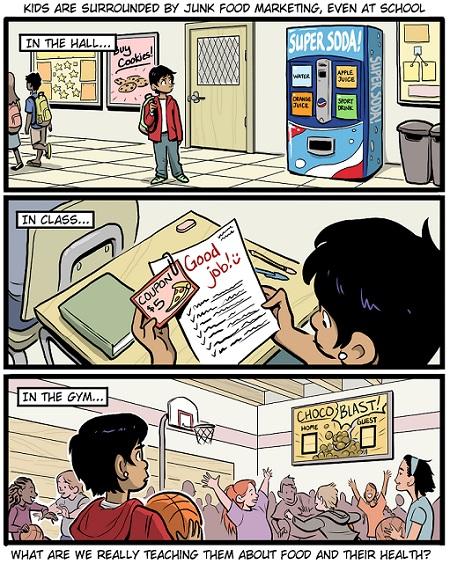
As school starts, so will the barrage of marketing and advertising targeting students. Brand logos, spokes-characters and product names are all over schools. The U.S. Government Accountability Office (GAO) found them on signs, posters, and scoreboards; vending machines; curricula, textbooks, and other educational materials; school equipment (e.g., uniforms, cups, water coolers, beverage cases, food display racks); school buses; and ads in school newspapers, yearbooks, and on school radio stations. The GAO found widespread marketing in conjunction with fundraisers; incentive programs (e.g., pizza coupons given as a reward for reading); school discount nights at fast-food and other restaurants; label redemptions programs that provide funds to schools in exchange for consumer purchases; sponsorship of school events, materials, and programs; and scholarships. Whew!
Food products are the most heavily marketed products in school – and we’re not talking about carrots and celery! Soft-drink bottling companies enter into multi-year exclusive contracts with districts that bring product and branded vending machines, scoreboards, coolers, and other paraphernalia into the schools. One study found that the average high school in Montgomery County, MD had 21 vending machines -- each one both selling product and functioning as a billboard. Younger students, in schools without vending machines, are typically given free coupons as incentive to try out food products.
Marketing is intended not only to persuade children to want and consume more, but also promotes the idea that they can derive identity, fulfillment, self-expression, and confidence through what they buy. When children are occupied with consumer-oriented activity (shopping, for example, or thinking about products or fantasizing about purchases), they simply have less time and brain-space for other things such as creative thinking and play, family and friends, artistic endeavors, or spiritual practices. The materialistic values encouraged by our marketing-driven consumer culture are associated with higher rates of anxiety, depression, psychological distress, chronic physical symptoms, and lower self-esteem.
Marketing in school can take up school time, contradict what children learn in their classes (especially about proper nutrition), and create an environment that encourages them to uncritically accept sponsors’ points of view.
Given the threats posed by advertising and marketing in school, how is it possible that so many principals, district administrators and parent groups are eager to embrace it? Perhaps because even if they are aware of the harm marketing can do, the immediate need for school funding is often so glaring that it obscures them. The threats, in contrast to financial need, are longer-term, less obvious, and more insidious.
States have been cutting funding to schools for quite some time now and school districts across the nation are so fiscally stressed that they are ever more open to the enticements of corporate marketing campaigns billed as “partnerships” that might bring in some money—any money at all. However, there is little evidence that allowing ads in schools brings in much money.
Nevertheless, district administrators eager to make up shortfalls in school funding, and under pressure to demonstrate to critical legislators that they are trying to do so, are willing to latch onto any half-baked scheme to show they are trying. This is a perfect environment for companies that recognize that students are a captive market of great value. They are eager to jump on the opportunity to generate immediate sales and/or a lifelong customer base.
Stripping away the rosy language of “school-business partnerships,” “win-win situations,” and “giving back to the community,” what you see when you look at corporate marketing activities in schools is example after example of the exploitation of children for corporate financial gain. All marketing in schools poses a threat to children. It is past time for considering whether marketing activities belong in schools. Schools should be marketing-free zones.
Photo Credit: Upstream Public Health




The views and opinions expressed in this post are those of the author(s) and do not necessarily reflect those of MomsRising.org.
MomsRising.org strongly encourages our readers to post comments in response to blog posts. We value diversity of opinions and perspectives. Our goals for this space are to be educational, thought-provoking, and respectful. So we actively moderate comments and we reserve the right to edit or remove comments that undermine these goals. Thanks!